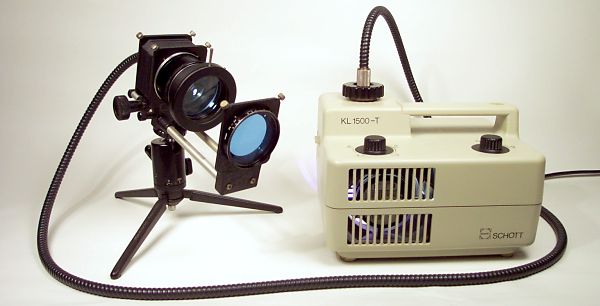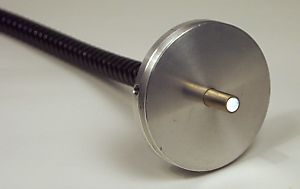
|
The Microscope Lamp.
Design Considerations for the Ideal Köhler Illuminator. |
Page 4 of 5 |

|
The Microscope Lamp.
Design Considerations for the Ideal Köhler Illuminator. |
Page 4 of 5 |
The light source used with the optimized condenser in this example is the Schott KL1500 cold light source. The lamp is a 150W, 15V tungsten halogen lamp with its own ellipsoidal reflector, contained in a fan-cooled housing along with light-attenuating filters and transformer power supply. The unit can make use of light guides having circular fibre bundles of 3mm to 8mm in diameter. 
Microscope lamp with fibre optic light-guide source. Control of light intensity is achieved by an internal wheel of inconel metal film on glass filters which reduce the light by approximately one photographic stop (half) for each click on the 5-step wheel, allowing a stepwise control of light intensity with no change of colour temperature. Later models of this light source replaced the filter wheel with a variable resistor(?) arrangement which gave continuous control of the light, but with change of colour temperature in the process. The earlier model is preferable, especially if photomicrography is the intention.  The light guide is held in an adapter blank drilled to provide a neat sliding fit for the light guide ferrule, which is clamped by means of a hex-socket grub screw tightened with an Allen key. The filament source and the light-guide source can be easily interchanged without upsetting the microscope lamp if the position of the light guide is adjusted so that the end of the guide locates in the same plane as the filament of the tungsten bulb.
The light guide is held in an adapter blank drilled to provide a neat sliding fit for the light guide ferrule, which is clamped by means of a hex-socket grub screw tightened with an Allen key. The filament source and the light-guide source can be easily interchanged without upsetting the microscope lamp if the position of the light guide is adjusted so that the end of the guide locates in the same plane as the filament of the tungsten bulb.
 The two images to the right have been obtained by using the above lamp and condenser to project an image of the guide end onto a white screen. The first is an image at best focus and full aperture, and the other is at the same focus and at much reduced aperture. A fairly even fill of the active aperture of the guide can be obtained by rotating the other end of the guide at the lamp housing and clamping it in the optimum position.
The two images to the right have been obtained by using the above lamp and condenser to project an image of the guide end onto a white screen. The first is an image at best focus and full aperture, and the other is at the same focus and at much reduced aperture. A fairly even fill of the active aperture of the guide can be obtained by rotating the other end of the guide at the lamp housing and clamping it in the optimum position.
Due to slight differences in orientation of individual fibres at each end of the guide, the fill will never be completely uniform, so the final result is a fairly uniform circular source of intense light 5mm in diameter which can be varied over a 16:1 brightness range without change in colour temperature. The circular shape is ideally suited to the illumination of the circular optics of the microscope. The ability to substitute light-guides of 3mm to 8mm diameter greatly increases the freedom to illuminate microscope condenser optics of different diameter over a much greater range of lamp distance. In particular, when used with the lowest power objectives, the largest light-guide allows the lamp to be moved very close to the microscope whilst still filling the aperture of a low power substage condenser. These condensers are not so sensitive to spherical errors introduced by having the lamp close, and by this means large fields can be satisfactorily illuminated. The large diameter of the source also allows a large lamp condenser to be easily filled with light, minimizing the effects of any spherical errors that the condenser may have. The light-guides available for the Schott (and other) fibre light sources can greatly extend the range of lighting possibilities for the microscopist. If for example a three branch flexible light-guide is used, one of the guides can be used to power a Köhler lamp providing brightfield, darkfield or Rheinberg illumination via the microscope substage, and the other two used above the stage to provide incident illumination. Once the lighting balance has been established, all three sources can be made to simultaneously increase or decrease in brightness by using the single control at the lamp power supply. This is especially useful in complex lighting arrangements when exposures must be bracketed. Additionally and importantly, the light provided is effectively filtered of its heat component which means that the microscope lamp housing does not grow hot. The heating effect at the specimen is also greatly reduced. Even though the guide attenuates the light by about 50%, the tightly focused spot from the ellipsoidal reflector lamp ensures an intensity at the exit end of the guide close to that of a normal tungsten microscope lamp -- but not as bright as the light from a bare quartz-halogen lamp. Due to considerations of the refractive index of the glass in the individual transmitting fibres, and total internal and external reflection phenomena occurring at the polished ends of the fibre bundle, the guide can only accept and emit light over a certain solid angle. For the Schott guides, this angle is about 88°, corresponding to an NA of 0.7, which also happens to be f 0.7. This means that even though aspheric condenser lenses are made with apertures approaching f 0.6, (acceptance angle 110°) there is no point in using one, as a fibre light-guide placed at its focus is incapable of completely filling it with light. This means that the present condenser with its aperture of f 0.7 is just large enough to accept all of the rays emanating from the light guide, and therefore represents an optimum match. (There would be some advantage in using the wider aperture lens with a tungsten filament source, as these are not restricted in the angle over which they emit light). The construction of the lamp allows for the easy substitution of other light sources, including white LEDs. These show increasing promise as microscope illuminants, and some of the issues involved in using them are dealt with on the following page. |